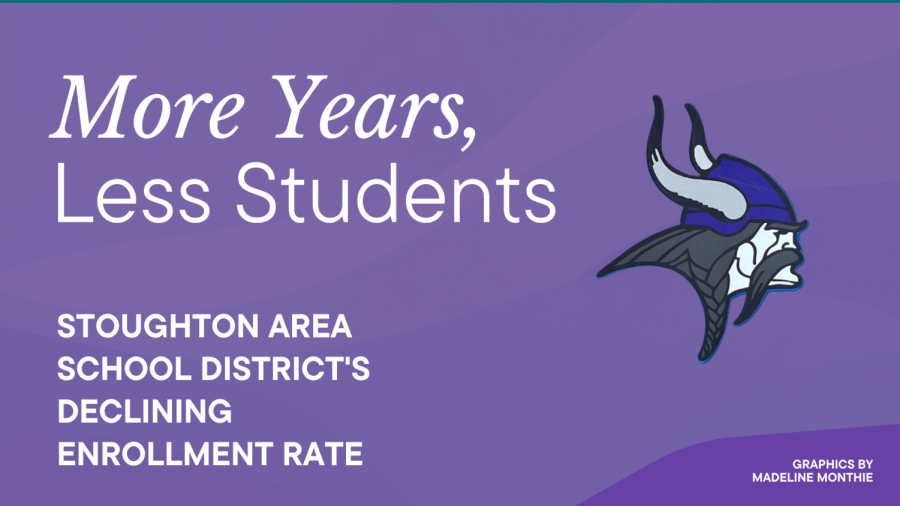More Years, Less Students
New roads are constructed, old roads are being renovated, a new business opens shop, and another neighborhood pops up. All of these projects and many more have occurred in Stoughton over the past few years, all part of an attempt to combat Stoughton Area School District’s declining enrollment rate. But how successful have these strategies been, and how does Stoughton’s declining enrollment rate impact the students and citizens of Stoughton?
The answer to this question lies within the demographics and statistics of Stoughton and other cities in Dane County. According to the 2021 census, Stoughton’s population is 13,085 people. Compared to neighboring towns, such as Oregon (11,407) and McFarland (9,325), Stoughton has a higher population. However, the latter school districts have more students enrolled in their districts than Stoughton, with Oregon’s student population being 4,119 and McFarland’s student population being 6,091. In comparison, Stoughton’s student population is approximately 2,765 students.
According to Stoughton’s Director of Business Services, Erica Pickett, the student population has not always been this way.
“[Declining enrollment] started in the district in 2002. That point in time was the peak of our enrollment. We were at about 3,600 students,” Pickett says. “[In 2002], graduating classes were hovering around 300 [students]. And since that point in time, we’ve been declining every year.”
One reason for this declining enrollment trend is the median age in Stoughton. As of 2022, Stoughton’s median age is 43.1, an increase from 41.4 in 2010. Stoughton’s median age is higher than the median age in Dane County of 35.2. However, both the median age in Stoughton and Dane County increased, with Dane County’s median age increasing from 34.3 in 2010.
The median age directly affects Stoughton’s enrollment rate, which can be seen through the student population. Although Stoughton’s overall population may seem higher than other neighboring towns, the majority of Stoughton residents are not enrolled in Stoughton schools, meaning the enrollment rate is lower than previous years.
Another contributing factor is the birth rate in Stoughton. Since 2000, the birth rate in Stoughton has decreased by 24%, meaning fewer children are being born. Therefore, fewer students are enrolling in the district. However, as of late, birth rates in Stoughton have seemed to stabilize due to the millennial population entering their thirties—a period of life that, according to past population trends shared by Pickett, adults tend to ‘settle down’ and have children. This could lead to not only increasing birth rates in Stoughton, but also an increasing enrollment rate when these children reach school age.
Although the enrollment rate in SASD is low right now compared to other cities and past years, this trend may not stick. Many housing opportunities await Stoughton residents, both new and old. Additionally, many newly approved housing developments are already in progress, such as the neighborhoods of Nordic Ridge and The Meadows. These neighborhoods hope to attract young families looking for starter homes to raise children in, which may raise the enrollment rate.
As stated by Pickett, Stoughton is also located near potential job centers, such as Epic, downtown Madison, an Amazon Distribution Center, and downtown Janesville, all of these locations a 30 minute drive from Stoughton. Recent improvements to Highway 51 and the interstate have increased this accessibility to nearby employment opportunities as well.
But how will the enrollment rate affect students? Many worry that classes and extracurriculars could receive less funding. According to Dan Keyser, SASD’s superintendent, this is not the case.
“We want to preserve the things that make us great. So we want to preserve our clubs, athletics, course offerings, and so forth,” Keyser says. “We’re a district that really believes in student-based scheduling. We allow students to say, ‘these are the courses we want to take’, and then we base section allotments on how many kids select a particular course. So, [if] more kids want to take a course, [that course is] going to have more sections […] If less kids take a course, then that [course] will have less sections.”
Keyser believes that the community plays a role in the enrollment rate as well.
“I believe strongly that our school district exists because our community exists,” Keyser says. “[Addressing the declining enrollment rate] is a coordinated effort and, fortunately, we’ve been working with the mayor and the Chamber [of Commerce], and businesses [in Stoughton], and I know they all have the same belief that we are stronger when working together than we are as separate entities. And so what benefits the school districts benefits the community and benefits the businesses.”
Keyser is hopeful that the enrollment rate will increase and is eager to take steps to make that happen, saying, “I’m eager and open for sitting down with anyone who has an idea of how we might attract and bring new students to the community and into the schools.”

Madeline is a senior, and this is her third year on staff! She's the features editor and social media manager. She joined the Norse Star because she loves...







